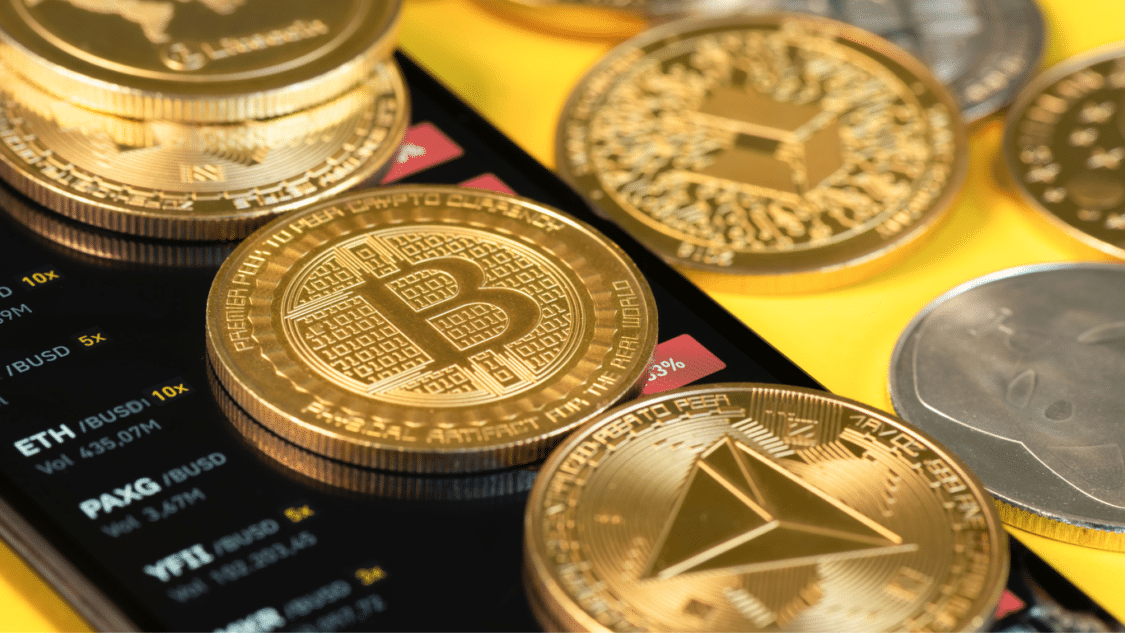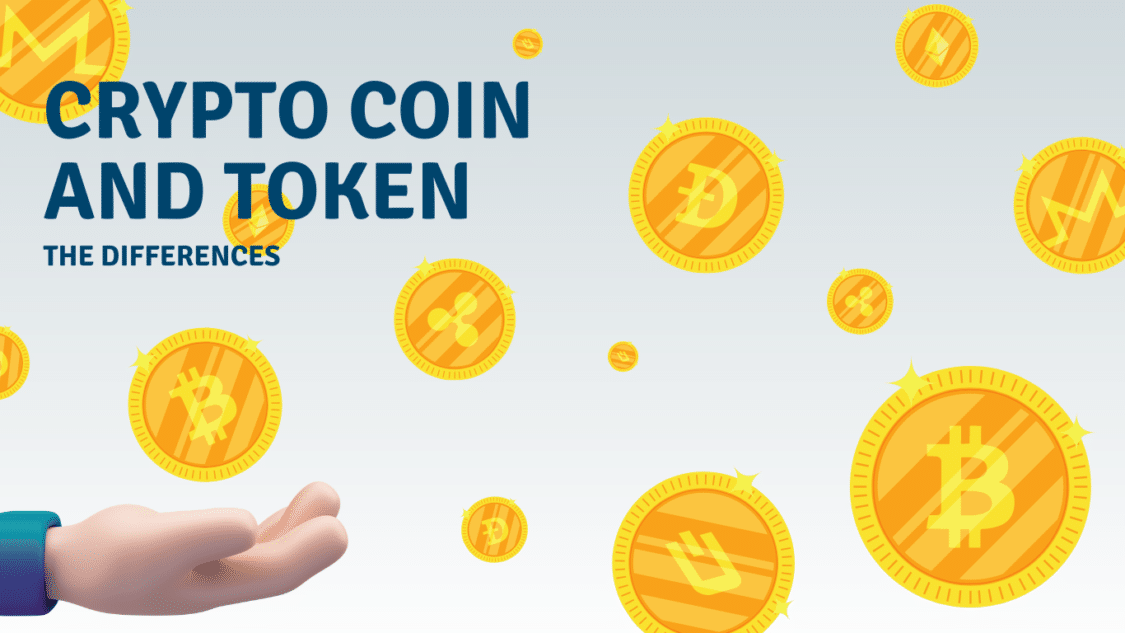The terms cryptocurrency coin and token are often used interchangeably, even though they have different meanings. Fundamentally speaking, they are similar because they both have value and are used for making payments. The difference is in terms of utility. Crypto coin and token are used for different things. Often, a Crypto coin can be used, while a Crypto token cannot be used, and vice versa. In addition, some marketplaces out there refrain from accepting tokens; however, coins are accepted.

Cryptocurrency coins and tokens are similar comparisons to traders and investors. We know that all traders invest; however, not all investors trade. Let’s discuss the differences between coins and tokens so you know what you’re referring to next time you use these terms.
What is a Crypto Coin?
A cryptocurrency coin is a digital currency that operates on a decentralised blockchain network. It serves as a medium of exchange, similar to traditional currencies, but with distinct characteristics. Unlike fiat currencies regulated by central banks, cryptocurrency coins are typically created through mining or pre-mining.
Blockchain technology forms the foundation of cryptocurrency coins. It’s a distributed ledger that ensures transaction records’ transparency, security, and immutability. This decentralised nature sets them apart from traditional banking systems, as any central authority does not control them. Instead, consensus mechanisms like proof-of-work or proof-of-stake validate transactions.

Cryptocurrency coins exist exclusively digitally, represented by cryptographic codes stored in digital wallets. Transactions occur electronically through peer-to-peer networks, eliminating the need for intermediaries. Additionally, many coins have a limited supply, meaning a finite number can ever be created. This scarcity, coupled with decentralisation, often contributes to their perceived value.
Crypto coins serve various purposes within their ecosystems. While some primarily act as mediums of exchange, others offer additional functionalities. They can grant access to specific services, enable participation in decentralised applications, or function as governance tokens. Prominent examples include Bitcoin (BTC), the pioneering decentralised crypto coin, and Litecoin (LTC), known for its faster and lighter approach to transactions.
What is a Token?
Cryptocurrency tokens possess distinct characteristics that set them apart within the digital asset landscape. These tokens are built on established blockchain platforms like Ethereum, which pioneered smart contracts and introduced token standards such as ERC-20, ERC-721, and ERC-1155. Each platform offers unique functionalities and standards for token creation and operation.
Tokens serve a multitude of roles in their respective blockchain ecosystems. They can represent digital assets and ownership rights or provide access to specific services. Some tokens enable utility within decentralised applications (DApps), facilitating transactions and granting special features. Others act as security tokens, symbolising ownership in traditional assets or supporting fundraising initiatives like ICOs and token sales.
Governed by specific token standards defined by each blockchain platform, tokens adhere to guidelines that dictate their behaviour and functionality. ERC-20 defines the basics for fungible tokens, while ERC-721 is dedicated to non-fungible tokens (NFTs) representing unique assets. These standards ensure compatibility and seamless integration across various applications and platforms.
Tokens come into existence through a variety of creation and distribution methods. Smart contracts on the blockchain platform are used to mint tokens, while distribution can occur through sales, crowd sales, airdrops, or rewards for participation. The blockchain records and verifies token ownership and distribution, ensuring transparency and immutability of token-related transactions.
Furthermore, Crypto tokens are not limited to a single blockchain platform. They can be transferred and utilised across compatible platforms using cross-chain bridges or decentralised exchanges (DEXs). This interoperability enables tokens to leverage the capabilities of multiple blockchain networks, expanding their reach and utility. Prominent examples of cryptocurrency tokens include Tether (USDT), a widely-used stablecoin operating on numerous blockchains, as well as ERC-20 tokens such as Chainlink (LINK) and Uniswap (UNI), renowned within the Ethereum ecosystem for various purposes.
The process of creation and the purpose
Coins are born through the intriguing mining process, revolutionising financial systems as trailblazing digital currencies. Miners deploy specialised hardware, employing computational power to validate transactions and secure the blockchain network. Racing against each other to solve intricate cryptographic puzzles, the first successful miner is rewarded with freshly minted coins.
This decentralised mining process ensures coin creation while upholding network integrity, empowering individuals with efficient and secure transactions that transcend geographical boundaries. Coins establish trust, store value, and enable peer-to-peer transfers, fostering financial sovereignty and catalysing the growth of a decentralised global economy.
Tokens emerge from the realm of smart contracts, harnessing the power of programmable logic on blockchain platforms like Ethereum. These creative blueprints define rules and parameters for token creation, distribution, and management, breathing life into tokens with just a few lines of code. As the genesis of decentralised ecosystems, tokens encompass a broader spectrum of purposes beyond currencies. They fuel innovation, serve as the lifeblood of these ecosystems, and drive engagement.
Tokens represent ownership rights, grant access to services, and enable participation in governance. They empower projects to forge vibrant economies within their platforms, facilitating crowdfunding, incentivising user involvement, and unlocking new dimensions of utility and value. In this dynamic realm, tokens open a gateway to endless possibilities.
Coins vs Crypto Tokens – The Differences:
Cryptocurrencies can be confusing, especially when it comes to understanding the difference between coins and tokens in crypto. Although the terms are often used interchangeably, they have distinct characteristics worth exploring.
We have prepared for you a Cryptocurrency coin and token list of differences:
1. Structure and Purpose:
Crypto Coins – Independent Currencies: Coins are like digital versions of traditional money. They have their own blockchain networks and function as standalone currencies. Bitcoin and Litecoin are examples of coins. They are used for transactions, storing value, and as a unit of account, redefining the concept of money.
Crypto Tokens – Adaptable Entities: Tokens, on the other hand, are more versatile. They are built on existing blockchain platforms like Ethereum. Tokens can represent assets, commodities, or even project-specific utilities. They power decentralised applications (DApps), enable decentralised finance (DeFi) protocols, and support crowdfunding through initial coin offerings (ICOs). Tokens offer flexibility and customisation within the crypto landscape.
2. Creation and Distribution:
Crypto Coins – Mined Into Existence: Coins are typically created through mining. Miners rely on powerful computers to confirm transactions and ensure network security. By solving complex puzzles, miners earn newly minted coins as a reward. This process provides a decentralised distribution mechanism and establishes consensus among network participants.
Crypto Tokens – Created via Smart Contracts: Tokens are created using smart contracts. These contracts automate the creation, distribution, and management of tokens. Developers can customise token functionalities through programmable logic, such as supply, ownership, and transfer mechanisms. Smart contracts empower innovators to tokenise various real-world assets and unlock new possibilities.

3. Value and Adoption:
Crypto Coins – Recognised as Currencies: Coins derive their value from scarcity and utility. As independent currencies, their worth is determined by market demand and acceptance. The wider adoption of coins as mediums of exchange and stores of value solidifies their value proposition. Coins tend to have higher liquidity and enjoy broader acceptance across different platforms.
Crypto Tokens – Value Through Success: Tokens also have value, but it is closely tied to the success of the projects or ecosystems they represent. Their value depends on the viability and utility of the underlying platform or DApp. Tokens offer unique functionalities within their ecosystems, enabling users to access services, participate in governance, or receive rewards. Token value is influenced by the project’s success, subjecting it to factors beyond market dynamics.
The Most Popular Coins and Tokens:
Coins:
- Bitcoin (BTC): Bitcoin is the first and most well-known cryptocurrency, often called digital gold. It introduced the concept of decentralised digital currency and remains the largest cryptocurrency by market capitalisation. Bitcoin continues to serve as a store of value and a medium of exchange, driving the development and adoption of blockchain technology.
- Ethereum (ETH): Ethereum, a decentralised platform, brought about a revolution in the world of cryptocurrency with its groundbreaking introduction of smart contracts. It allows developers to build and deploy decentralised applications (DApps) and launch their own tokens through initial coin offerings (ICOs). Ethereum’s blockchain has become the foundation for a vast ecosystem of decentralised finance (DeFi) applications, non-fungible tokens (NFTs), and more.
- Binance Coin (BNB): Binance Coin is the native cryptocurrency of the Binance exchange, one of the largest and most popular cryptocurrency trading platforms. BNB serves various purposes within the Binance ecosystem, including discounted trading fees, participation in token sales on the Binance Launchpad, and the Binance Smart Chain (BSC) ecosystem. BNB’s utility and growing adoption have propelled it to a prominent position in the market.
Tokens:
- Chainlink (LINK): Chainlink is a decentralised oracle network that aims to connect smart contracts on the blockchain with real-world data and external APIs. It provides a secure and reliable way for blockchain applications to access off-chain information, making it a critical component for building decentralised applications that require external data inputs.
- Uniswap (UNI): Uniswap is a decentralised exchange (DEX) protocol built on the Ethereum blockchain. It allows users to trade ERC-20 tokens directly from their wallets without the need for intermediaries. Uniswap’s automated liquidity provision and use of smart contracts make it a popular choice among traders and liquidity providers in the decentralised finance (DeFi) space.
- Tether (USDT): a stablecoin is designed to maintain a value equivalent to a traditional fiat currency like the US dollar. It provides stability to the volatile cryptocurrency market by offering a 1:1 ratio between the token and the underlying fiat currency. Tether is widely used to preserve value and facilitate liquidity across various cryptocurrency exchanges and platforms.
Can Crypto coin become a token? The transition from a token to a crypto coin typically occurs when a token migrates from a blockchain platform like Ethereum to its independent blockchain network. This process is known as tokenisation.
Tokenisation allows a project or blockchain platform to establish its infrastructure, separate from the original blockchain it was initially built on. By migrating to its blockchain, the token gains greater control, autonomy, and functionality, resembling the characteristics of a coin.
This transition often involves a token swap or token migration event, where token holders exchange their existing tokens on the original blockchain for the new coins on the newly created blockchain. This migration typically enhances scalability and security and offers additional features or capabilities unavailable on the original blockchain.
Once the migration is completed, the token becomes a fully independent coin with its blockchain network, consensus mechanism, and governance structure. The newly minted coin can then be used as a standalone digital currency, similar to other coins like Bitcoin or Litecoin.
It is worth noting that not all Crypto tokens will undergo this transition. Some tokens may remain on their original blockchain platforms, serving specific functions or utilities within their respective ecosystems. The decision to become a coin depends on the goals and requirements of the project and the community supporting it.
How is a Coin/Token Evaluated and How to Choose Between Them?
Several crucial factors must be considered when evaluating and choosing between different coins and tokens in the cryptocurrency market. Understand the coin’s or token’s purpose and utility – does it solve a real-world problem? Evaluate its use case and potential for widespread adoption.
Research the project team’s experience and track record, seeking transparency and progress in the development roadmap. Assess the underlying technology for scalability, efficiency, and security, considering any unique features or advancements. Consider the strength and engagement of the project’s community and partnerships with reputable organisations that can add credibility.
Evaluate the market demand for the cryptocurrency coin or token, look for a genuine need and assessing competition within the same niche. Analyse the token economics, including supply and utility within the ecosystem, and understand the project’s governance structure. Evaluate potential risks, such as regulatory, technological, and market risks, and consider the project’s challenges.
Conduct thorough research from reliable sources, read whitepapers, review the project’s website, and stay informed about industry news. By carefully considering these factors and conducting thorough due diligence, you can make more informed decisions when evaluating and choosing between different Crypto coins and tokens in the cryptocurrency market. Always exercise caution and never invest more than you can afford to lose.
What Risks are Associated With Coins and Tokens?
Cryptocurrencies are highly volatile, experiencing significant price fluctuations driven by market sentiment, regulations, and global economic conditions. Investors must be cautious and prepared for these fluctuations. The lack of regulation in the cryptocurrency space exposes investors to risks such as market manipulation, fraud, and security vulnerabilities. Conducting thorough due diligence and using reputable platforms are crucial to mitigate these risks.
Security vulnerabilities are a significant challenge in cryptocurrencies. Exchanges and wallets stand in the crosshairs of hackers, drawing their attention to potential breaches. Strong security measures like secure storage and two-factor authentication are essential to protect digital assets. Market manipulation, regulatory uncertainties, technology risks, limited adoption, and speculative market trends are additional challenges investors should consider when dealing with cryptocurrencies.
conclusion
cryptocurrency coins and tokens have distinct characteristics that differentiate them. Coins function as independent digital currencies with their own blockchain networks, while tokens are built on existing platforms like Ethereum. Coins are primarily used for transactions and storing value, while tokens offer versatility and customisation within decentralised ecosystems.
Coins are created through mining and have limited supplies, while tokens are generated via smart contracts and can represent assets, ownership rights, or provide access to services. The value of coins and tokens is influenced by market demand, scarcity, utility, network effects, and investor sentiment. However, they also come with risks such as volatility, security vulnerabilities, and regulatory uncertainties.
When evaluating coins and tokens, consider their purpose, team experience, technology, market demand, token economics, and potential risks. Popular coins include Bitcoin, Ethereum, and Binance Coin, while notable tokens include Chainlink, Uniswap, and Tether. Conduct thorough research and exercise caution when investing in the cryptocurrency market.
Stock Value and Price(Opens in a new browser tab)
Reasons Why Forex Traders Lose Money(Opens in a new browser tab)




